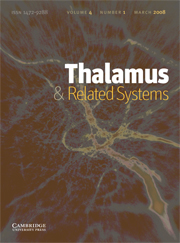Article contents
Comparative physiological and serotoninergic properties of pulvinar neurons in the monkey, cat and ferret
Published online by Cambridge University Press: 18 April 2006
Abstract
The basic electrophysiological properties and responses to serotonin of thalamocortical (TC) neurons in the ferret, cat, and monkey pulvinar were compared. Morphologically, thalamocortical neurons in these three species were similar, except for the presence of beaded dendrites in many monkey neurons. In all three species, the neurons exhibited two distinct firing modes: single spike activity and low threshold Ca2+-spike mediated bursting. However, in monkeys, the low threshold Ca2+ spikes were followed by a prominent 50–100 ms afterhyperpolarization that could result in the generation of an additional rebound Ca2+ spike. The application of 5-HT to thalamocortical neurons in cat and monkey pulvinar resulted in a depolarization and an increase in membrane conductance through an enhancement of the hyperpolarization-activated cation current, Ih, apparently through the activation of 5-HT7 receptors. In contrast, the application of serotonin to ferret pulvinar neurons resulted in a prominent hyperpolarization, owing to an increase in membrane potassium conductance. In monkey and ferret, application of serotonin could result in barrages of IPSPs in thalamocortical neurons. These results indicate that there are significant species-dependent differences in both the electrophysiological and pharmacological properties of pulvinar thalamocortical neurons.
Information
- Type
- Research Article
- Information
- Copyright
- Elsevier Science Ltd
- 4
- Cited by

